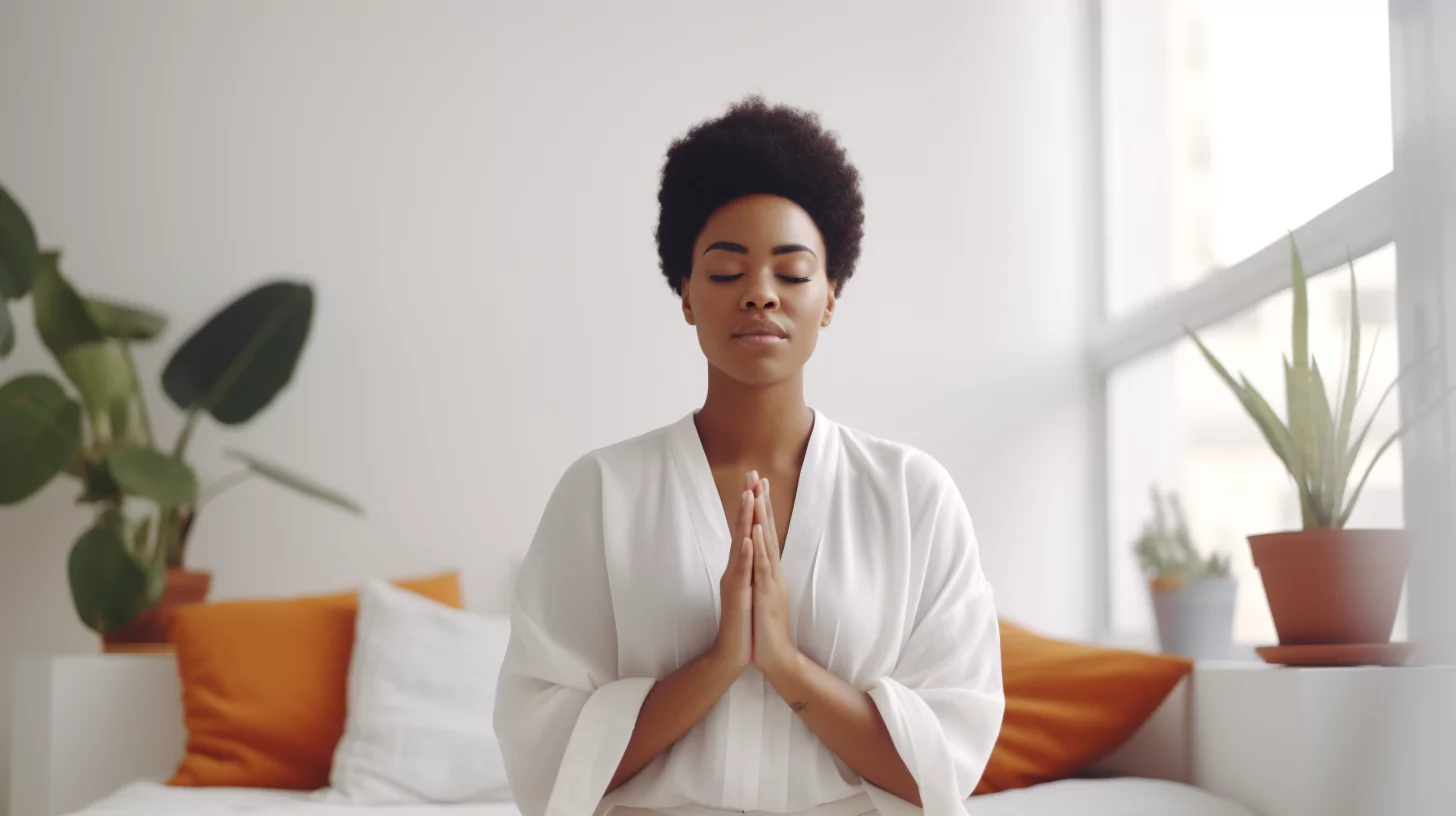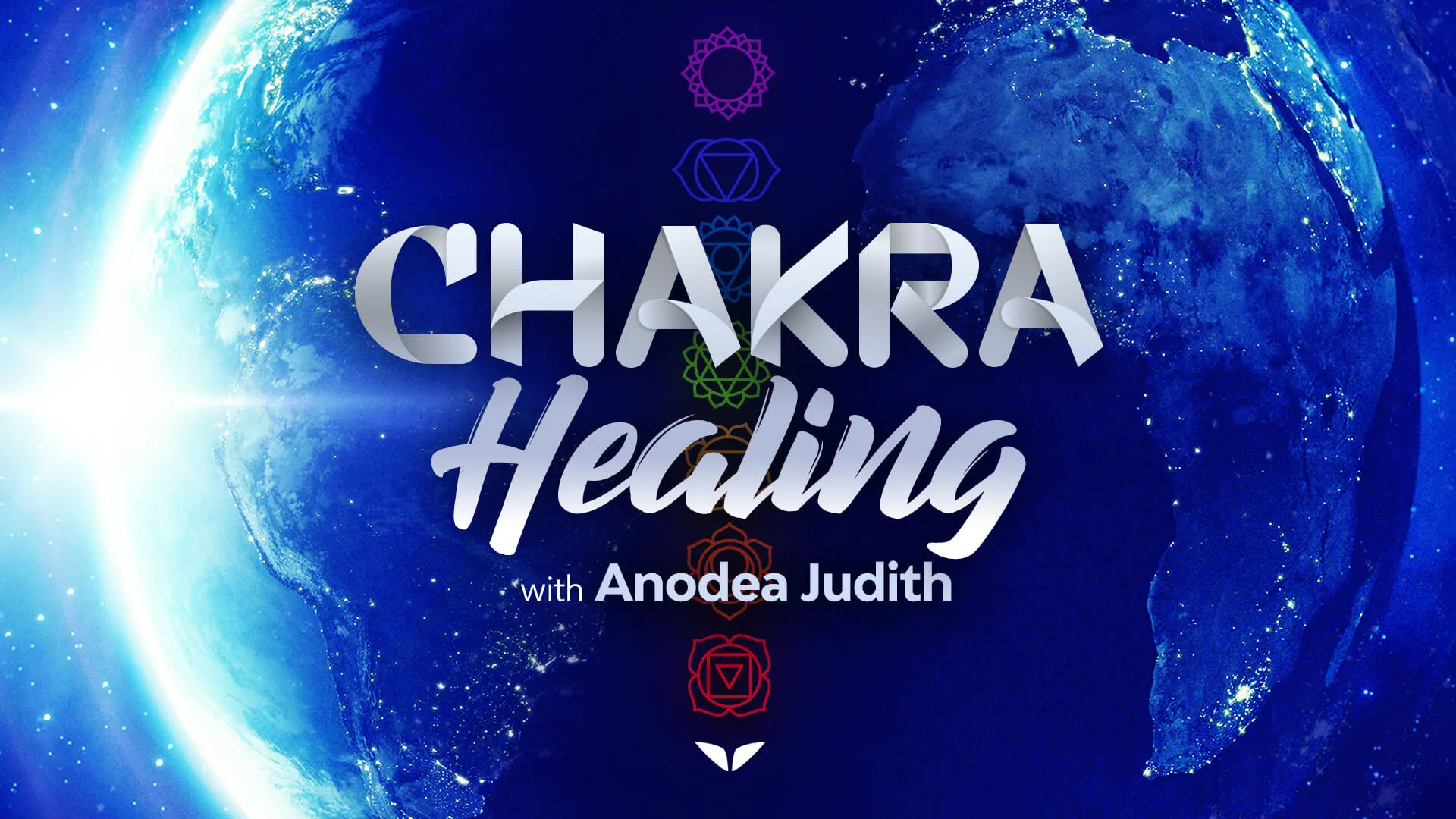The heart chakra is a very complex energy point that represents transformation and integration. It dwells on the love and unity of seemingly opposite powers, such as that of the spirit and that of matter.
It’s also known as a heart center because it connects three upper-body chakras and three lower-body chakras at one point.
To understand how to work with it, it’s essential to understand its complexity. Once you do, you will have a profound knowledge of the various techniques you can apply to heal and open it.
And most importantly, you will be able to choose the optimal one for your case.
What Is the Heart Chakra?
In Sanskrit, this chakra is called “Anahata.” In fact, it is the spiritual place where past experiences and grievances can no longer harm us.
The Anahata chakra is associated with the color green, which represents transformation and love energy.
Those with an open, well-balanced heart chakra are full of love, forgiveness, and compassion. But if this chakra is blocked, anger, grief, hatred, and jealousy will manifest.
Learning how to open the heart chakra is a beautiful experience. Whether this energy center was blocked in your childhood or due to a recent heartache, opening the heart is the start of your healing process.
Where Is the Heart Chakra Located?
The love chakra is located in the center of the chest and corresponds to the heart, lungs, thymus gland, and cardiac plexus.
In the seven chakras system, it’s the fourth chakra, positioned in between the three lower body chakras and the three upper body chakras.
This is where the physical and spiritual come together, so it’s the core of our energetic frequency and the root of all emotional and energetic healing.
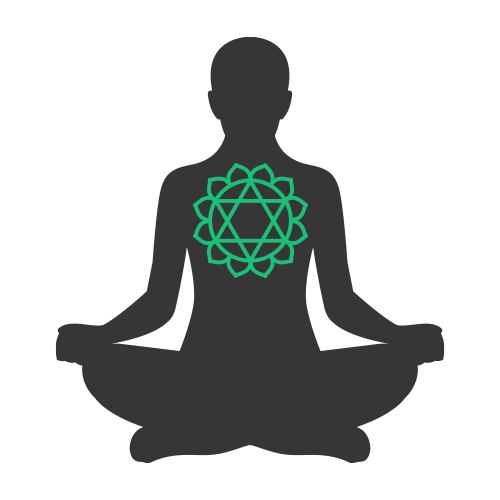
What’s the Symbol of the Heart Chakra?
The symbol for the heart chakra is composed of the following elements:
- A six-pointed star, or hexagram, also referred to as Shaktona
- Twelve petals positioned in a circle depicted with a green color; this part of the symbol is sometimes referred to as a twelve-petaled lotus flower
- In the Hindu tradition, the deity associated with the heart chakra is Vayu, who sits at the center of the symbol, riding an antelope or deer
- Inside the main circle, we can find another eight-petaled circle, also referred to as the eight-petalled lotus (in the Hindu tradition)
Learn more about chakra symbols: Chakra Symbols & Their Meanings: How to Unlock Your Energy Body.
The symbolism of the hexagram
The hexagram is made of two interlaced triangles, one pointing up and one pointing down. They symbolize the power of spirit and matter coming together—the feminine and masculine in harmony.
It’s the concept of the divine trinity forming the star as a symbol of the harmony of the two, emphasizing the function of the heart chakra as a center of integration and connection.
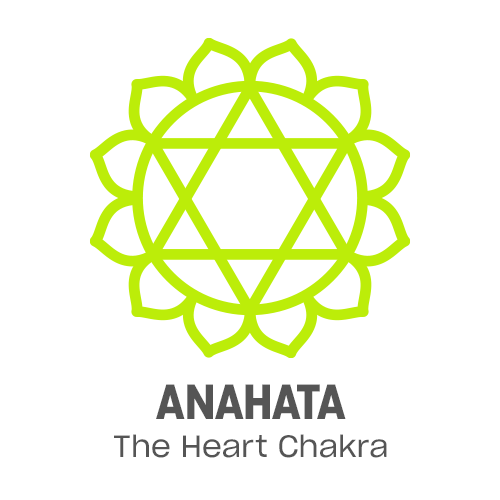
The symbolism of the twelve petals
On each petal is inscribed a Sanskrit syllable:
- Kam,
- Kham,
- Gam,
- Gham,
- Ngam,
- Cham,
- Chham,
- Jam,
- Jham,
- Nyam,
- Tam, and
- Tham.
Energy flows in and out of the petals, carried by the syllable sound, in twelve directions.
Each petal represents a plexus where the energy channels converge. The syllables symbolically represent the vital energy that comes from these points.
These energy movements are activated with each breath and correspond to twelve mental states: fraud, lustfulness, indecision, hope, anxiety, repentance, possessiveness, incompetence, discrimination, impartiality, arrogance, and defiance.
The list varies from one tradition to another.
The center of the heart chakra: diety, seed syllable, and animal
At the center of the fourth chakra symbol, there is a deity, an accompanying animal, and a seed syllable.
The deity is called Rudra or Ishana Rudra Shiva and comes in union with the goddess Kakini Devi considered the doorkeeper of the heart chakra.
The seed syllable “Yam” (or “Yang”) represents the air or wind element. This sound, or “mantra,” is connected to the control over air and breath.
The deer or antelope is the carrier of the seed sound. This animal symbolizes the heart and its qualities—gentleness and grace, compassion and empathy.
This is why it’s responsible for acceptance and forgiveness. It also mirrors the energies or processes that we go through as human beings and as eternal souls.
So the heart chakra is responsible for everything related to transformation and change.
When Does the Heart Chakra Open?
Living from an open Anahata is truly a joyous and engaging experience.
When your heart opens:
- You feel an abundance of empathy, compassion, and love
- You are altruistic and respect others
- You emanate peace and resilience, as it helps you attain tranquility and keep it intact in the face of challenges and conflicts
A balanced chakra allows you to be who you are instead of attempting to conform to external expectations.
You aspire to evolve as a human being, welcoming change and uncertainty in life. And as a spirit, you embrace your spiritual journey without running away from spiritual growth.
What Blocks the Heart Chakra?
Numerous things can cause an energetic blockage, including illness, stress, and emotional conflict. And when the heart’s energy is blocked, it can harm your physical, spiritual, and emotional health.
This can translate into poor circulation and blood pressure extremes in the body, as well as health issues with the heart, lungs, and upper extremities.
Spiritually, a blocked fourth chakra can cause a feeling of disconnect, a lack of empathy, and an inability to trust oneself or others.
Common symptoms include:
- Deep insecurity
- Fears
- Jealousy
- Loneliness
- Depression
- Selfishness
- Inability to give and receive unconditional love
If left unchecked, these can grow into manipulative behaviors.
How to Balance the Heart Chakra
If you’re experiencing the symptoms of the blocked Anahata, there are many ways to heal the imbalance. From meditation to singing bowls to yoga, when the chakra is balanced, you will feel warm and compassionate.
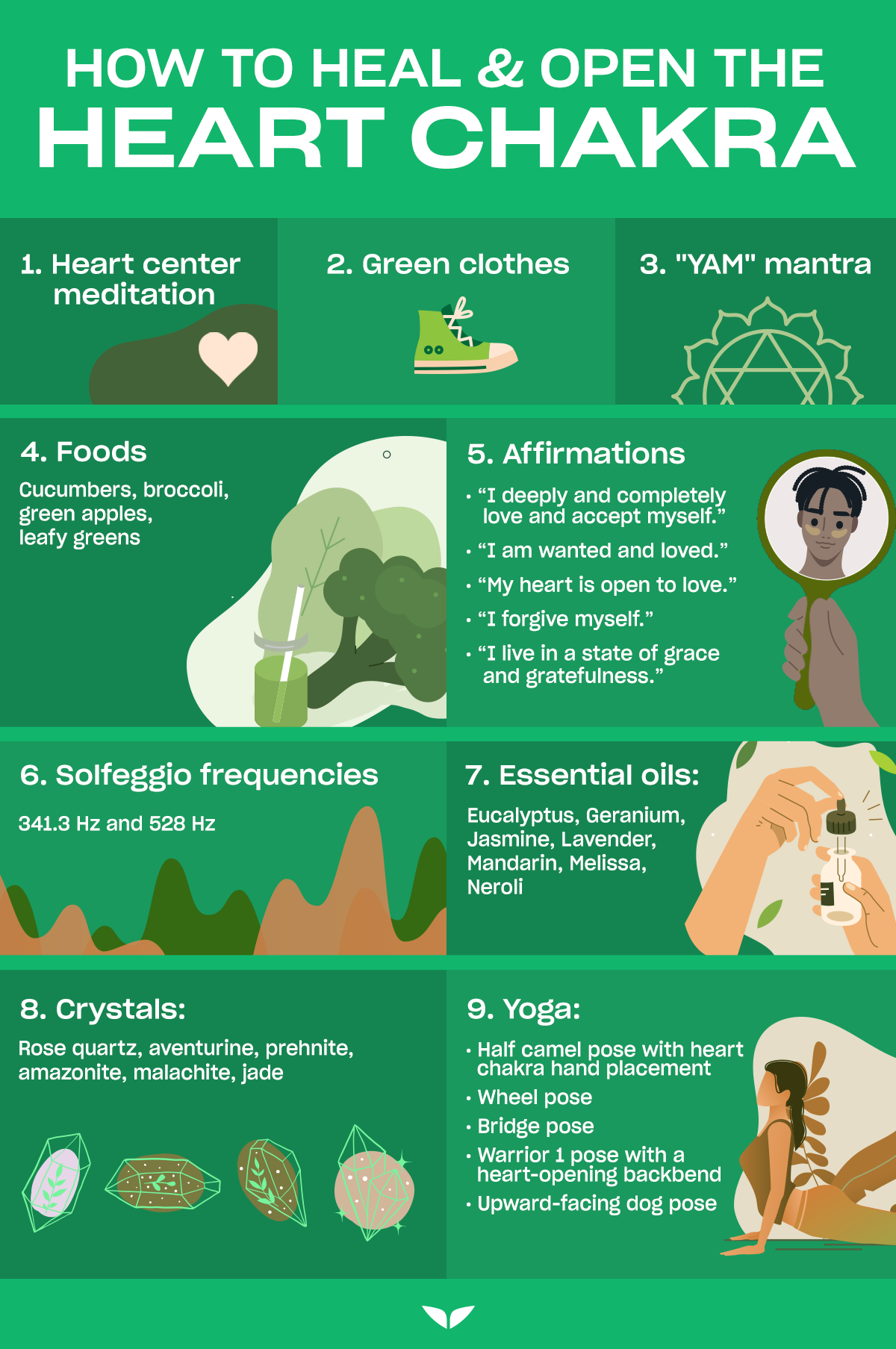
Let’s take a closer look at the nine ways to heal and open your love chakra.
1. Heart chakra meditation
Meditation can help you restore your energy flow. And since meditation is such a deeply personal experience, you should take time to find a practice that works best for you.
Here are a few meditation tips:
- Wear comfortable clothing
- Sit or lie in a position that doesn’t strain your spine or joints
- Find a place in which you won’t be disturbed
- Try a guided meditation to get started
2. Color of the heart chakra
Every chakra has its color. The color green is associated with the fourth chakra. And you should find ways to incorporate this color into your daily life.
Add some green clothing to your wardrobe, and decorate your workspace with green accents. Plants are a great way to add greenery and life to your workspace.
3. Mantra chanting
Numerous sounds resonate with the chakras.
In many different traditions and mystery schools across the planet, including ancient Egyptians, Hebrew, Islamic, Tibetan, Japanese, and Native Americans, there are several different systems of sacred vowels to balance the chakras.
Each chakra corresponds to a particular seed syllable called bija, which can be used to create mantras. These syllables reflect each chakra’s essence and help to clear and strengthen the associated energy.
The spoken bijas are chanted out loud to resonate with the chakras.
The corresponding spoken bija for the fourth chakra is “yam,” which is considered the seed of the heart and depicted in the heart chakra symbolism.
So the mantra for the Anahata is “YAM.”
Chant this to heal both the physical and the spiritual heart center and to open yourself up to unconditional love and compassion.
Mantras can be repeated vocally or sub-vocally while you meditate.
4. Green food
It might seem too simple to be true, but green food can help you heal your heart chakra. So introducing more healthy green foods such as broccoli, cucumbers, green apples, and leafy greens is a great idea.
5. Heart chakra affirmations
Positive affirmations can help you increase the positive energy associated with the fourth chakra. These can include little notes you leave for yourself on the bathroom mirror or computer monitor.
Examples of positive heart affirmations include:
- “I deeply and completely love and accept myself.”
- “I am wanted and loved.”
- “My heart is open to love.”
- “I forgive myself.”
- “I live in a state of grace and gratefulness.”
6. Heart chakra frequency
Because music speaks deeply to the human spirit, one great way to bring balance and harmony to body, mind, and spirit is by using sacred Solfeggio frequencies such as 341.3 Hz and 528 Hz.
If you want to find the secrets of the Universe, think in terms of frequency, energy, and vibration.
— Nicola Tesla
Solfeggio tones trace back centuries; they are considered sacred and made up of six tones, where specific Solfeggio frequencies can be attuned to energetic points and bring healing and restoration.
341.3 Hz
The heart chakra frequency is 341.3 Hz, associated with the element of air. Listening to the music attuned to this particular frequency brings balance to the love chakra.
528 Hz
The 528 Hz frequency is the most significant of the ancient Solfeggio Frequencies. Known as the “love” frequency, it has a deep-rooted relationship with nature and is present in everything from chlorophyll to human DNA.
Listening to music attuned to the 528 Hz Solfeggio frequency will help you recalibrate your DNA structure and open your heart chakra to unconditional love.
Tibetan Bowls
Tibetan singing bowls have been used for centuries for healing and meditation purposes. They create a range of sounds that restore the normal vibratory frequencies of out-of-harmony parts of the body, mind, and soul.
Each chakra resonates with a specific key. The heart chakra key is K.
The Tibetan singing bowls can be attuned to a specific key for optimal balancing. Listening to the recording of them with the appropriate pitched tones will heal and open your Anahata.
7. Essential oils
Essential oils can help you balance your heart by elevating your inner state and external environment.
Easy ways to use essential oils:
- Diffuse
- Put one drop on your hands and inhale
- Add 5 drops of essential oil to every 10 ml of any base oil. Massage this mixture onto your skin and rub it in
- Add 1-2 drops to every quarter-size pump of your favorite lotion
- Add 15-20 drops to a bathtub
Oils for balancing the heart chakra:
- Eucalyptus
- Geranium
- Jasmine
- Lavender
- Mandarin
- Melissa
- Neroli
- Orange
- Pine
- Rose
- Rosewood
- Sandalwood
- Tangerine
- Ylang Ylang
- Yarrow
8. Crystals
Depending on the crystal’s vibrational frequency, you can use them to balance your energy center, amplify your field and space, and heal emotional traumas.
One of the best crystals for your love chakra is rose quartz crystal. It works both on your heart organ and heart energy.
Some of the benefits include:
- Helps heal from trauma and emotional wounds
- Attracts romantic love and other forms of love, such as friendship
- Cultivates inner peace and joy
And because this chakra’s color is green, you also won’t get it wrong by choosing green crystals such as:
- Aventurine
- Prehnite
- Amazonite
- Malachite
- Jade
9. Yoga heart-opening asanas
1. Half-camel pose with heart chakra hand placement
The half-camel pose is a deep backbend for your upper back and literally and metaphorically opens up your heart space. By bringing your hand to touch your heart chakra, you’re activating this opening even more.
How to do it:
- Kneel with your shoulders stacked over your hips and your hips stacked over your knees
- Bring your palms, fingers facing down, to the tops of your glutes
- Start to press your hips forward as you lean your heart back
- Bring one hand to your heart chakra, with the option to grab your heel with your other hand for more intensity
- To come out, activate your core and slowly re-stack your shoulders and hips
2. Wheel pose
The wheel pose develops mobility and flexibility in your spine and hip flexors, as well as creating space in your heart.
How to do it:
- Start on your back with your feet on your mat and knees to the sky
- Bring your hands to your mat by your ears, with your fingers facing your shoulders and elbows to the sky
- On an inhale, press evenly into your hands and feet to push yourself up
- Option to come to the balls of your feet for more intensity
- To come out, tuck your chin towards your chest and slowly lower to your mat; your hips are the last thing to touch down
3. Bridge pose
The bridge pose is a gentler variation of the wheel pose, and it begins to create flexibility and strength in your spine. This pose also lifts and opens your heart toward the sky.
How to do it:
- Start on your back with your feet on your mat and knees to the sky
- Bring your arms by your sides with your palms face-down by your hips
- On an inhale, press into your feet to lift your hips toward the sky
- Try to evenly distribute weight between your feet and the base of your shoulders without putting too much pressure on your head and neck
- For more intensity, interlace your fingers under you and squeeze your shoulder blades together
- To come out, slowly lower your spine on an exhale
4. Warrior 1 pose with a heart-opening backbend
The warrior 1 pose strengthens your quads while creating flexibility in your hips. We’ll add a gentle backbend to this pose to tap into that heart chakra energy.
How to do it:
- Find a Warrior 1 stance with your front knee stacked over your front ankle and your back foot planted firmly down at about a 90-degree angle
- Bring your hands to your low back, and slowly start to inch them down your back leg
- As you do this, keep your hips moving forward as you allow your chest to lift up
- Option to look up, adding a little throat chakra action as well
5. Upward-facing dog pose
The upward-facing dog strengthens and tones your arms while creating flexibility in your spine. It’s a great, gentle pose to practice if you spend a lot of time on a computer.
How to do it:
- Begin lying face down on your mat with the tops of your feet on your mat
- Bring your palms directly under your shoulders and allow your elbows to point toward the sky
- Press into your hands to lift your head, neck, and shoulders off the mat, then press into the tops of your feet to lift your quads off the mat as well
- Keep your neck neutral by gazing forward
6. Reverse plank pose
The reverse plank pose strengthens your arms, legs, back, and core while opening your heart center up towards the sky.
How to do it:
- Begin seated on your mat with your legs extended
- Bring your palms by your hips, fingertips facing your toes
- Inhale to press into your hands and feet and lift your hips toward the sky
- Option to bring your gaze behind you, opening your throat, for more intensity
7. Bow pose
The bow pose generates mobility in your spine as well as flexibility in your hip flexors.
How to do it:
- Begin lying face down on your mat with the tops of your feet on your mat and your palms by your hips
- Bend your knees to bring your feet towards your glutes
- Lift your head, neck, and shoulders as you simultaneously reach for your ankles, heels, or toes
- Inhale to kick into your hands, deepening the expansion in your chest
- When you’re ready, slowly release it into your belly

Heal Your Heart Chakra
This seemingly simple energy center plays an incredibly essential role in the awakening of your being to unconditional love and self-empowerment.
Once healed and fully opened, its energy can bring healing to all of humanity. Yet, it’s crucial to understand that healing your Anahata is a process.
Once you become aware of this powerful center and intend to open it, restore its energy flow, and constantly keep it balanced, it sets you up for evolution.
Welcome in.
—
Images generated on Midjourney.

